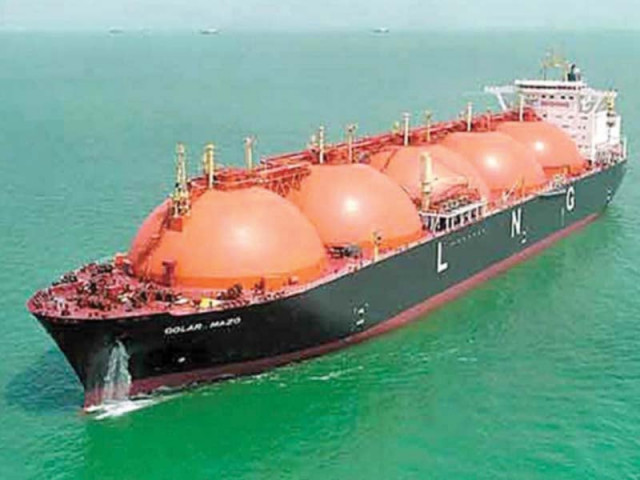Islamabad:
Pakistan decided Tuesday to request the renegotiation of its liquefied natural gas import agreement (LNG) with Qatar after its industry has slowed down and the request for electricity has dropped, which has led to more than 50 excess cargoes in the coming years and half.
The agreement, which will expire in 2031, left the decision -makers with the policies of two options – that is to closure of its 400 mmcfd per day, installations for the production of cheaper local gas as well as the diversion of expensive excess gases for subsidized residential use or the renegotiation of the agreement.
The Economic Coordination Committee (ECC) of the firm has enabled the oil division to engage with Qatar to renegotiate import volumes in order to minimize the diversion of imported gas to residential consumers and to import only what is necessary, according to the people who attended the meeting of the ECC on closed do.
The Minister of Petroleum, Ali Perviz Malik, is expected to go to Qatar because the Pakistani authorities do not yet know if Qatar would also be willing to reopen import volumes, the sources added.
Based on the official evaluation, there will be at least 51 excess cargoes worth 1.2 billion dollars to $ 1.5 billion from July this year to December 2026, according to sources.
After having assumed his duties in March this year, Ali Perviz Malik recommended that the power division fulfills its responsibilities by raising the imported gas quota of 600 mmcfd promised, or there will be no other option than to request the renegotiation.
According to a declaration from the Ministry of Finance, which concerns the question, “the ECC examined the overall situation of the supply of the gas sector in the country and ordered the Ministry of Oil to take effective measures to control losses in the sector and ensure operational efficiency”.
The sources have indicated that, given the excess costly gas imported, the government has three options. Pakistan can ask Qatar to reduce the number of monthly cargoes to around 6 to 7 compared to the existing 9. The second option is that the government can request an extension of the expiration period with the request to postpone the delivery of the excess cargoes beyond the initial expiration period of 2031.
The sources have indicated that the third option of non-performance damage clause (NDP) is given in the contract under which Qatar can sell gas to third party and claim losses of Pakistan, if the price of the sale of gas is lower than the price of the contract.
Pakistan is forced to pay for the volumes of LNG contracted even if they are not consumed. The contract allows flexibility to adjust the contribution to three cargoes per year.
The Pakistan-Qatar GNL agreement includes two major agreements signed in 2016 and 2021, aimed at meeting the energy needs of Pakistan thanks to LNG long-term supply contracts.
The sources have said that Pakistan would open to end the agreement in 2026, if the two parties do not agree on a new gas price. The 2016 agreement allows termination after 11 years, which is the year 2027, if the renegotiation of prices failed in 2026. The 2021 agreement has a shorter 4 -year exam period, from 2026, but a fixed end date of 2031 unless Renegotié or terminated early.
The 15 -year agreement allows Pakistan to import up to 3.75 million tonnes per year (MTPA) of LNG to resolve its energy deficit. The 2016 agreement was signed at 13.37% of the price of crude brent oil. Each cargo corresponds to around 100 million cubic feet per day (MMCFD), totaling 500 mmcfd.
The 10 -year agreement of 2021 provides up to 3 MTPA of LNG at a rate lower than the 2016 agreement. It was signed to replace expired and more expensive contracts and ensure the security of the offer.
The price of the 2021 agreement was 10.2% of the crude Brent, a reduction of 31% compared to the rate of 13.37% of the 2016 agreement.
Pakistan has already postponed five cargoes from the 2016 to 2026 agreement without financial penalties.
Due to slow economic growth, resulting in a drop in demand for electricity from the national network and low global demand and very unaffordable prices, the government was not entirely managing LNG power plants, which was one of the reasons for the import of gas.
Due to approximately RS3,500 by the price of MMBTU imported gas, the government cannot divert gas to households without undergoing heavy losses.
LNG has been mainly imported to meet the demand for the energy sector while balance has been made available to industry. The LNG sales purchase agreements (SPAS) transported a 100% socket or payment clause for PSO / PLL while instead of reflecting the same clauses, gas supply agreements (GSAS) with power plants were initially executed at 66% of the minimum and revised sources and later revised at 50% with effect from January, added.
Before the commissioning of these power stations based on LNG, it has been assumed that these most effective factories would be placed higher in the order of economic merit (EMO) and / or to be declared as advanced factories for advanced charges that have not occurred, they added.
Over time, LNG demand in the power sector has considerably reduced due to the availability of generation from other sources that have led to excess LNG problems in the system. This overabundance of GNL in the system has also been exacerbated with a drastic decline in LNG consumption by captive electric power plants due to the taxation of the network transition.
The sources indicated that the SNGPL indicated that around 11 cargoes were surplus for July to December 2025 and, the same for the calendar year 2026, some 40 LNG cargoes are estimated at a surplus, taking into account the planned demand from the electricity sector and the destruction of the request in the CPP.
This translates into $ 1.2 billion to $ 1.5 billion in unnecessary import bill for a country whose exchange reserves almost 100% are based on foreign loans.
Sources have indicated that SNGPL is forced to divert the expensive RLNG to the domestic sector. To cope with the question of LNG surplus, the SNGPL uses the reduction in gas production forms local fields, which between 250 and 400 mmcfd, to maintain the integrity and safety of the system due to higher line pressures.
The reduction in local production in turn has an impact on the income of exploration and production companies in addition to having an impact on the production of condensates, crude oil and GPL in petroleum and gas fields, they added. In accordance with the estimated income requirements (ERR) for CFY such that determined by OGRA, the cost of the diversion of the RLNG in the inner sector on the SNGPL network was estimated at RS242 billion compared to 24 cargoes, which has led to an increase in consumer gas prices, the sources said.
The only option for Pakistan is now to ask the fraternal country to examine the agreement in light of these developments, have added the sources.




